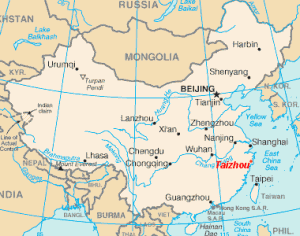One of the major issues will be how to ensure that the money loaned to the poor can be paid back. Yunus’ system in Bangladesh is organizing groups and having the group members meet every week and monitor within themselves. But this model may not be duplicable to China.
China is diversified and fragmented in local culture. Microfinance is in theory a workable and sustainable model, but in practice varies very much. The trust mechanism is one of the top issues that very dependable on local culture. Microfinance offers loans on a non-mortgage basis, which means that the risk of running such programs is very high, which puts the trust mechanism at the very core of promising the success of any microfinance projects. Only with a proper mechanism can a loan officer collect all kinds of decentralized information the people asking for a loan and therefore truly understand him or her.
Take Taizhou as an example. Taizhou is a city located in Zhejiang Province, one of the prosperous provinces on the Southeastern seaside. In 2008, Taizhou achieved a GDP at 196.53 billion RMB. Taizhou’s City Commercial Bank has been running microfinance program for 30 years, and its non-performing assets is kept under 2%, while loan offered has reached RMB 50 million. On average each family/individual gets RMB 46,000. Up till now, the loans offered are all paid back on time.

The bank offers microcredit from RMB 2000 to three millions, with a time limit from one to three years. The annual interest rate is 14%, and the loans targeted mainly at individual businesses and small enterprises that have experience of more than three months and assets less than RMB 30 million. Farmers who have lost their land composed a large group of their clients. Most of their clients are for the first time dealing with the banks, and even never thought of getting loans from the banks. Debtors do not have to provide sophisticated documents, and no business plans or feasibility reports are required.
Here is how Taizhou model of trust mechanism works: loan officers from the City Commercial Bank of Taizhou are all local people who can speak Taizhou dialect. They make use of their own personal network to gather information about the debtor on his or her personal financial status and business operations. The officers understand local culture and have the say on offering the loan or not. The president of the bank phrases the loan management system as ‘soft information’, which is one of the most fundamental ways of solving the information asymmetric problem in microfinance.
The City Commercial Bank of Taizhou’s success in running microfinance is based on the local knowledge of its loan officers. But not every other local bank can duplicate this model. The means to get all the ‘soft information’ needed to insure the minimum level of risk are informal and rely heavily on social network. It will only happen when a community is inter-related and where individuals care about their reputation in the community.
Local challenges vary from place to place, and also depend on the main purpose of the programs. In Taizhou, where the economic development is comparatively booming, the microfinance project is more emphasized on incubating more self-sufficient individuals/families that can help local economy. Therefore, Taizhou model is more commercialized, and the risk is more under control. However, in some other rural areas or countryside, some microfinance projects aim at assisting the poor, which makes the projects more close to charity.
In Taizhou, three major local banks are all competing for microfinance business, while in counties such as Haidong in Qinghai Province, most of the organizations running microfinance are registered under Civil Administration Department. Their status of being non-professional-financial-organization puts them at a disadvantaged place: they cannot legally accept savings from citizens, neither can they finance themselves from the banks. Lack of relevant legal protection is also limiting the development of microfinance in China.
Even other than that, many more blocks are on the road, including overly restrictive government regulations, complex logistical challenges, lack of expertise and insufficient funding.
World Microfinance Forum in Geneva, Switzerland, recently presented a report, stating that there were only about 100 poverty-alleviation-focused microfinance non-governmental organizations in China, serving an estimated 150,000 clients, while only about 10 NGOs can independently cover the costs of their loans.
Hans Rosling, the Swedish academic made famous by his lively talks at TED, made clear with his visualization on the rise of Asia. He graphs global economic growth since 1858 and predicts that India and China will outstrip the United States. China is indeed making great efforts on fighting against poverty, but honestly, microfinance has yet to really impact a significant amount of Chinese people to a capacity that it truly can.
Inviting Yunus to China cannot solve the problem. Microfinance in China still has a long way to go: on the uncertain ground.
* Special thanks to SHI Ce (史册), a graduate from UIUC and who has done a field study at Taizhou, Zhejiang, on its microfinance system.
